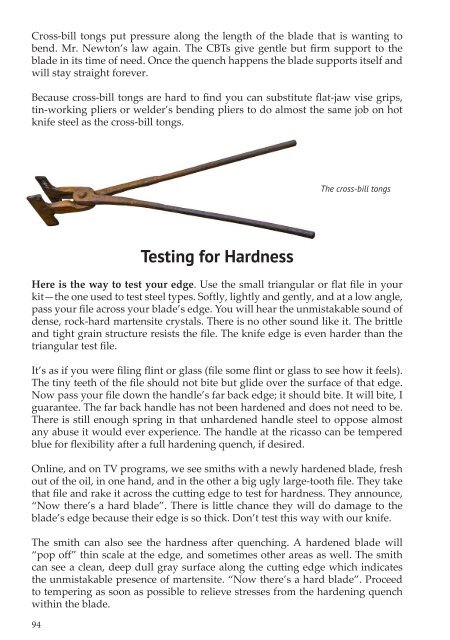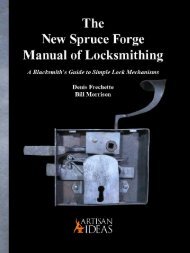FORGED: Making a Knife with Traditional Blacksmith Skills
This book will teach you to hand build a knife using the traditional method of blacksmiths of old — FORGING. Traditional forging of a knife blade is a process which uses the ancient techniques of moving hot steel with hammer and anvil alone into a knife-form that is ready for filing, heat treating and sharpening with no or very minimal electric grinding. This book also teaches traditional fit-and-finish skills using only hand tools. It explains an ancient riveted full-tang handle construction system that surpasses modern methods. In the author's words; "In my early blacksmithing years, I was lucky to get to know some old smiths who wrangled hot iron every day just to make a living. They unselfishly taught me traditional blacksmithing skills and knife forging methods. Every time I use those skills and methods, I honor their friendships, and by teaching you, the reader, we keep alive the memory of those old-time iron pounders." Hardcover, 132 pages, 150 photos and illustrations, $29.95.
This book will teach you to hand build a knife using the traditional method of blacksmiths of old — FORGING.
Traditional forging of a knife blade is a process which uses the ancient techniques of moving hot steel with hammer and anvil alone into a knife-form that is ready for filing, heat treating and sharpening with no or very minimal electric grinding.
This book also teaches traditional fit-and-finish skills using only hand tools. It explains an ancient riveted full-tang handle construction system that surpasses modern methods.
In the author's words; "In my early blacksmithing years, I was lucky to get to know some old smiths who wrangled hot iron every day just to make a living. They unselfishly taught me traditional blacksmithing skills and knife forging methods. Every time I use those skills and methods, I honor their friendships, and by teaching you, the reader, we keep alive the memory of those old-time iron pounders."
Hardcover, 132 pages, 150 photos and illustrations, $29.95.
Create successful ePaper yourself
Turn your PDF publications into a flip-book with our unique Google optimized e-Paper software.
Cross-bill tongs put pressure along the length of the blade that is wanting to<br />
bend. Mr. Newton’s law again. The CBTs give gentle but firm support to the<br />
blade in its time of need. Once the quench happens the blade supports itself and<br />
will stay straight forever.<br />
Because cross-bill tongs are hard to find you can substitute flat-jaw vise grips,<br />
tin-working pliers or welder’s bending pliers to do almost the same job on hot<br />
knife steel as the cross-bill tongs.<br />
The cross-bill tongs<br />
94<br />
Testing for Hardness<br />
Here is the way to test your edge. Use the small triangular or flat file in your<br />
kit—the one used to test steel types. Softly, lightly and gently, and at a low angle,<br />
pass your file across your blade’s edge. You will hear the unmistakable sound of<br />
dense, rock-hard martensite crystals. There is no other sound like it. The brittle<br />
and tight grain structure resists the file. The knife edge is even harder than the<br />
triangular test file.<br />
It’s as if you were filing flint or glass (file some flint or glass to see how it feels).<br />
The tiny teeth of the file should not bite but glide over the surface of that edge.<br />
Now pass your file down the handle’s far back edge; it should bite. It will bite, I<br />
guarantee. The far back handle has not been hardened and does not need to be.<br />
There is still enough spring in that unhardened handle steel to oppose almost<br />
any abuse it would ever experience. The handle at the ricasso can be tempered<br />
blue for flexibility after a full hardening quench, if desired.<br />
Online, and on TV programs, we see smiths <strong>with</strong> a newly hardened blade, fresh<br />
out of the oil, in one hand, and in the other a big ugly large-tooth file. They take<br />
that file and rake it across the cutting edge to test for hardness. They announce,<br />
“Now there’s a hard blade”. There is little chance they will do damage to the<br />
blade’s edge because their edge is so thick. Don’t test this way <strong>with</strong> our knife.<br />
The smith can also see the hardness after quenching. A hardened blade will<br />
“pop off” thin scale at the edge, and sometimes other areas as well. The smith<br />
can see a clean, deep dull gray surface along the cutting edge which indicates<br />
the unmistakable presence of martensite. “Now there’s a hard blade”. Proceed<br />
to tempering as soon as possible to relieve stresses from the hardening quench<br />
<strong>with</strong>in the blade.










